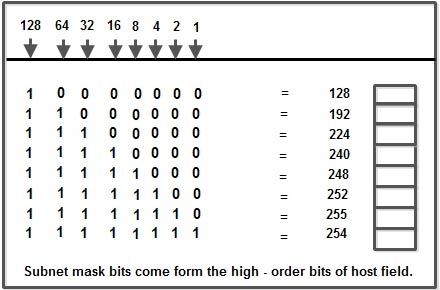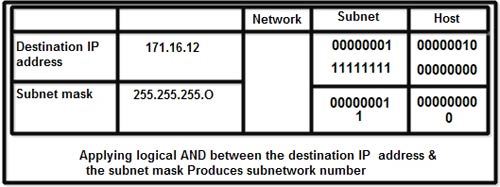• Subnet mask uses the same format and representation technique as IP addresses.
• Subnet mask has binary is in all bits specifying the network and subnet-work fields, and binary Os in all bits specifying the host field.
• A subnet address is created by borrowing the bits from host field.
• Subnet mask bits should come from the high-order (left most) bits of the host field.
• Various types of subnet mask exist for class Band C subnets.
• The default subnet mask for a class B address that has no subnetting is 255.255.0.0, while the subnet mask for a class B address 171.16.0.0 that specifies eight bits of subnetting is 255.255.255.0. The reason for this is that eight bits of subnetting or 28 – 2 (1 for the network address and 1 for the broadcast address) = 254 subnets possible, with 28 – 2 = 254 hosts per subnet.

• The subnet mask for a class C address 192.168.2.0 that specifies five bits of subnetting is 255.255.255.248 with five bits available for subnetting, 25 – 2 = 30 subnets possible, with 23 – 2 = 6 hosts per subnet.

How subnet masks are used to determine the network number
• The router performs a set process to determine the network (or more specifically, the subnetwork) address.
• First, the router extracts the IP destination address from the incoming packet and retrieves the internal subnet mask.
• It then performs a logical AND operation to obtain the network number. In logical AND operation, 1 “ANDed” with 1 yields 1 and 1 “ANDed” with 0 yields 0.
• This causes the host portion of the IP destination address to be removed, while the destination network number remains.
• The router then looks up the destination network number and matches it with an outgoing interface.
• Finally, it forwards the frame to the destination IP address.
• Figure shows that when a logical AND of the destination IP address and the subnet mask is performed, the sub-network number remains, which the router uses to forward the packet.

 Dinesh Thakur holds an B.C.A, MCDBA, MCSD certifications. Dinesh authors the hugely popular
Dinesh Thakur holds an B.C.A, MCDBA, MCSD certifications. Dinesh authors the hugely popular